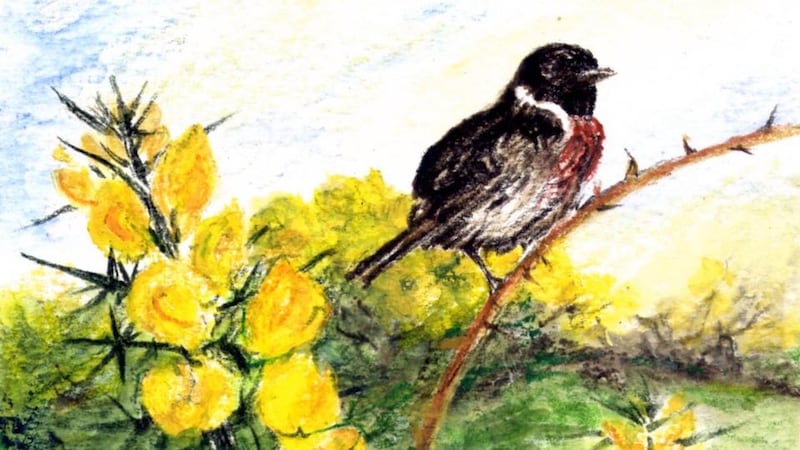A furze bush burns in a sizzling eruption, as its pyrolitic oil takes fire. Conifer forest burns with a roar, creating its own winds from superheated air. Both are now the sounds of the incendiary crisis in the uplands.
It comes from a coincidence of climate change with a change in the use – or disuse – of land, and the spread of a shrub that was once a mainstay of the rural economy. Now it is a useless weed that can cost farmers payments on land they may not even use.
“Gorse fires” is the headline term, but heather, hill grasses and sedges fuelled most of the fires that have raged across the island over the past decade. Spreading into forestry, some have become catastrophic.

One in north Co Mayo in 2008, which destroyed more than €1 million worth of trees, was ranked with major forest fires in Norway, Sweden and Germany. Between 2010 and 2015, as BirdWatch Ireland stressed this week, the cost to the exchequer of tackling 6,743 fires in 10 counties was more than €6 million.
In Northern Ireland this month the fire service has dealt with more than 500 fires, of which 466, it believes, were started deliberately
In Northern Ireland this month the fire service has dealt with more than 500 fires, of which 466, it believes, were started deliberately. In the Republic there have been 40 major fires, from Donegal to Cork, including the huge conflagration that still smoulders beyond the mountains across the bay.
All this is confused by traditions of burning dry, dead vegetation to prompt new growth for livestock. As a Teagasc agrienvironment conference heard this spring, there has been a steady decline in hill sheep farming over the past 15 years. Only 8,500 commonage farmers have sheep, and half of those declaring commonage as part of their land (for the basic farm payment) aren't actually grazing their hilly hectares at all.
If this goes on, the Teagasc research team warned, “vast tracts of commonage will become ineligible [and] completely abandoned, because market returns from hill sheep production are not economically justifiable in the absence of income supports.”
At the same time, remaining hill farmers have been pressing to burn the land for a later month in the spring. They complained that wet winters of climate change were making it impossible to burn before the cut-off point, on February 28th. This impelled Minister for Rural Affairs Heather Humphreys to propose, in a controversial amendment to the Wildlife Act, the freedom to burn in March.
My own rainfall record for April is the lowest ever, including a dozen dry days, and the first 10 days of May have yet to produce a drop of rain
There have, indeed, been some very wet winters. But this spring, in the west and north of the island, produced dawn-to-dusk sunshine of exceptional warmth and strong, drying winds from the east. My own rainfall record for April is the lowest ever, including a dozen dry days, and the first 10 days of May, as I write, have yet to produce a drop of rain.
To start fires so late for farming reasons shows unthinkable disregard, for both law and the natural world. Furze is a favoured nesting place for little birds (linnets, warblers, stonechats) and food and home for insects. A blazing furze bush is a furnace of wildlife.
The sweep of fire across open land – 25,000 hectares in each of two recent years – adds hares, badgers, lizards, frogs, mice, beetles and more to the victims. Yet, as Pádraic Fogarty of the Irish Wildlife Trust insists in his new book, Whittled Away: Ireland's Vanishing Nature, "From late March, through April and early May, even as late as June sometimes, is fire season."
Half a century ago, when AT Lucas wrote Furze, the history of gorse's myriad rural uses, for everything from forage to firewood, the big bushes of Ulex europaeus (or whins, if you're north of Westport) were "rarely seen above 500 feet in the west or 800 feet in the east" but had already become "little better than a troublesome weed".
Today, as it mounts the hillsides, it is an obstacle to keeping land in the “good agricultural condition” on which the basic farm payment depends.
Farmers were warned that burning furze out of season will lose them money, but no farmer with illegally burnt land has ever lost a euro
Farmers were warned in 2014 that using fire to burn furze out of season will lose them money, but, as the Irish Wildlife Trust has established, no farmer with illegally burnt land, even in areas of conservation, has ever lost a euro.
Nor does burning work all that well. Although a fierce fire will burn the bush above ground, its bank of seeds in the soil will germinate prolifically in the bare ground left afterwards. And burning young furze stimulates a forest of fresh shoots. Herbicide on sawn-off stumps is the recommended death – that, or extirpation with a digger.
The guidelines prescribed for burning heather seek to give it time to grow between fires. “For example, if you choose to burn when heather reaches 30cm and you estimate it will take around 20 years for plants to reach this height, you should have a 20-year rotation, with an average of one-twentieth of the area being burnt each year.”
That’s if there’s heather left to grow.
Michael Viney's Reflections on Another Life, a selection of columns from the past four decades, is available from irishtimes.com/irishtimesbooks









